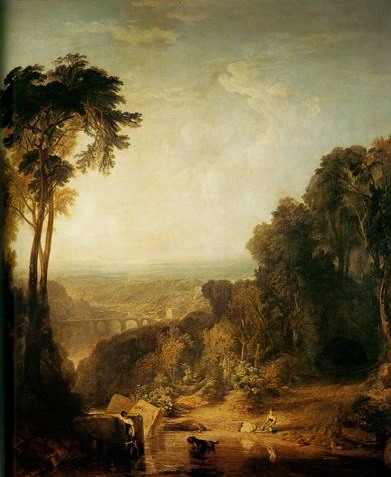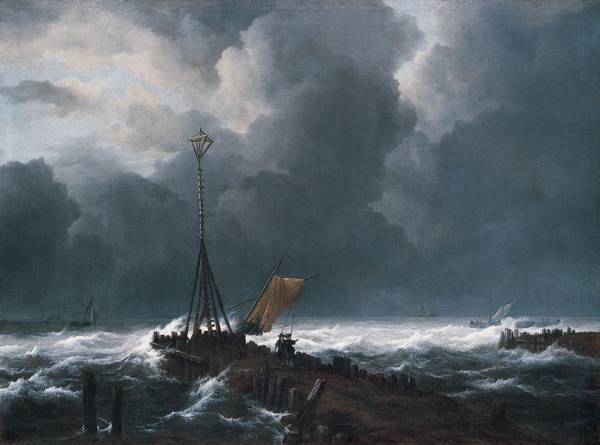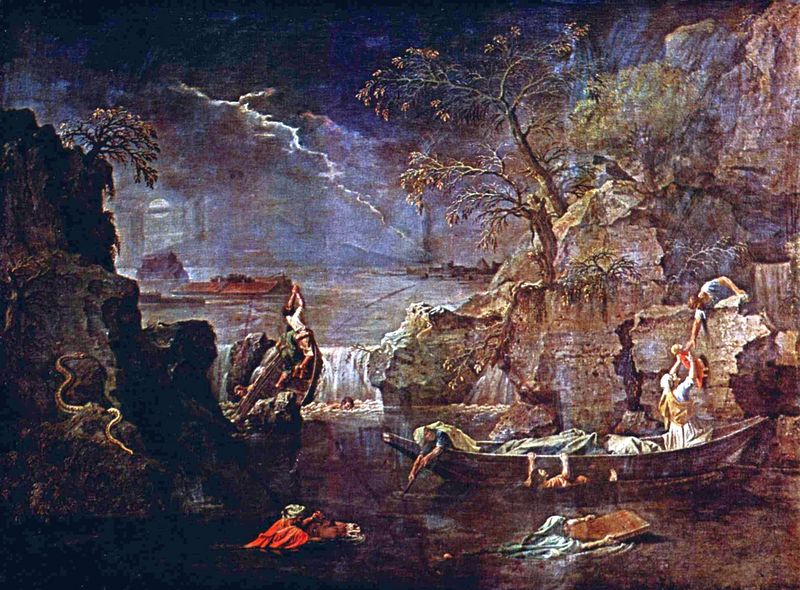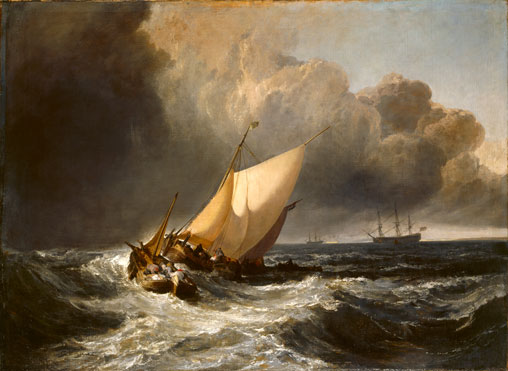Turner and the Masters at the Tate presented a selection of magnificent paintings by JMW Turner (1775-1851) alongside related works by the old masters and contemporaries he strove to imitate, rival and surpass. Bringing together around one hundred pictures of supreme historical significance from collections around the world, this was the first exhibition to look at Turner’s work in the company of his greatest predecessors.
The exhibition provided an unprecedented opportunity to view Turner’s works alongside a stunning array of masterpieces by more than thirty other artists, including Canaletto, Claude, Titian, Aelbert Cuyp, Poussin, Rembrandt, Rubens, Jacob van Ruisdael, Willem van de Velde, Veronese, Watteau, Constable, and R.P. Bonington. In so doing it allows us to appreciate that Turner’s responses to other artists were both acts of homage and a sophisticated form of art criticism, designed to demonstrate his understanding of the most celebrated masters, and his ability to make their art his own. The show tells this story in exciting, even unpredictable, ways, and confirms Turner’s reputation as a towering figure in the European landscape tradition.
The exhibition included comparative works such as

Rembrandt’s Landscape with the Rest on the Flight into Egypt 1647 (National Gallery of Ireland)

paired with Turner’s Moonlight, a study at Millbank exh.1797 (Tate);

Claude’s Moses saved from the Waters 1639 (Museo del Prado)

with Turner’s Crossing the Brook exh.1815 (Tate);

Ruisdael’s A Rough Sea at a Jetty c.1652–5 (Kimbell Art Museum)

alongside Turner’s Port Ruysdael exh.1827 (Yale Center for British Art);

Poussin’s Winter - The Deluge 1660–4 (Musee de Louvre)
paired with Turner’s The Deluge exh.1805(?) and RA 1813 (Tate);

and Willem van de Velde the Younger’s A Rising Gale c.1672 (Toledo Museum of Art) displayed for the first time in over 170 years

alongside Turner’s companion piece Dutch Boats in a Gale exh.1801 (Private Collection).
For the first time since they were shown together at the Royal Academy exhibition in 1832
Turner’s Helvoetsluys (Tokyo Fuji Art Museum, Japan)
was united with Constable’s Opening of Waterloo Bridge (Tate).
When the works were originally shown Turner famously added a red buoy to his seascape during the ‘varnishing’ period before the exhibition opened, apparently in order to compete with the bright reds of Constable’s adjacent work. Constable reportedly told a friend ‘Turner has been here and fired a gun’.
It was Turner’s strategy, almost uniquely within the history of European art, to enter into direct competition with artists both past and present, whom he considered as worthy rivals to his own fame. Turner built his reputation as an oil painter by challenging the works of old masters, deliberately producing paintings that could hang in their company. Often admired as an independent genius, he was in fact deeply engaged with the works of other artists. He studied the works of old masters, particularly those of the seventeenth-century landscape painter Claude Lorrain.
Joseph Mallord William Turner is regarded as being among the greatest artists in history, whose work was prolific and varied including drawings, prints, watercolours and oils. Born in London, Turner was the son of a barber of humble means. He entered the Royal Academy Schools in 1789 at the age of 14 before becoming a member of the RA in 1802 and Professor of Perspective in 1807.
Turner and the Masters had been conceived by David Solkin, Professor of the Social History of Art at the Courtauld Institute, University of London. The exhibition was co-curated by Ian Warrell, curator of 18th- and 19th- century British Art at Tate, and Philippa Simpson, a Tate-funded doctorial student at the Courtauld Institute, with Martin Myrone, curator of 18th- and 19th- century British Art at Tate.
.
A fully illustrated catalogue accompanied the exhibition, published by Tate Publishing. The exhibition toured to Le Grand Palais, Paris, from 22 February to 23 May 2010, and to the Museo del Prado, Madrid, from 22 June to 19 September 2010.
More Images and Image Credits:
Giovanni Antonio Canaletto, The ‘Molo’ from the Canal of San Marco. Oil on canvas, 48.5 x 80.5 cm., 1733 – 1734. Private collection
Joseph Mallord William Turner, Bridge of Sighs, Ducal Palace and Custom House, Venice: Canaletti Painting. Oil on mahogany, 51.1 x 81.6 cm., 1833. London, Tate

Willem Van de Velde The Younger, An English Ship in a Gale Trying to Claw off a Lee Shore. Oil on canvas, 160.2 x 132.8 cm., 1672. Greenwich, National Maritime Museum

Joseph Mallord William Turner, The Wreck of a Transport Ship. Oil on canvas, 172.7 x 241.2 cm., c. 1805 - 1810. Lisbon, Fundaçao Calouste Gulbenkian

Joseph Mallord William Turner, Aeneas and the Sibyl, Lake Avernus. Oil on canvas, 76.5 x 98.4 cm., 1798. London, Tate

Joseph Mallord William Turner, The Decline of the Carthaginian Empire. Oil on canvas, 170.2 x 238.8 cm., 1817. London, Tate

Joseph Mallord William Turner, Apullia in Search of Apullus, Learns form the Swain the Cause of his Metamorphosis. Oil on canvas. 148.5 x 241 cm., 1814. London, Tate

Joseph Mallord William Turner, Palestrina – Composition. Oil on canvas. 140.3 x 248.9 cm., 1828 - 1830. London, Tate
Joseph Mallord William Turner, The Tenth Plague of Egypt. Oil on canvas, 143.5 x 236.2 cm., 1813. London, Tate

Thomas Gainsborough, Boy Driving Cows near a Pool. Oil on canvas, 58.4 x 76.2 cm., 1786. London, Tate

Joseph Mallord William Turner, The Forest of Bere. Oil on canvas, 89 x 119.5 cm., 1808. London, Tate

Rembrandt van Rijn, Girl at a Window. Oil on canvas, 81.6 x 66 cm., 1645. London, Dulwich Picture Gallery

Joseph Mallord William Turner, Jessica. Oil on canvas, 122 x 91.5 cm 1830 London, Tate

Joseph Mallord William Turner, Rome, from the Vatican. Raffaelle, Accompanied by La Fornarina, Preparing his Pictures for the Decoration of the Loggia. Oil on canvas, 177.2 x 335.3 cm., 1820. London, Tate
John Constable, The Opening of Waterloo Bridge (‘Whitehall Stairs, June 18th 1817’). Oil on canvas, 130.8 x 218 cm., 1832. London, Tate
Joseph Mallord William Turner, Helvoetsluys. Oil on canvas, 91.4 x 122 cm., 1832. Tokyo, Fuji Art Museum
Joseph Mallord William Turner, Fishing Boats Bringing a Disabled Ship into Port Ruysdael. Oil on canvas, 91.4 x 123.2 cm., 1844. London, Tate
Jacob van Ruysdael, Rough Sea. Oil on canvas, 107 x 125.8 cm., c. 1670. Boston, Museum of Fine Arts. William Francis Warden Fund, 1957
William Turner, Snow Storm – Steam-Boat off a Harbour’s Mouth making Signals in Shallow Water, and going by the Lead. The Author was in this Storm on the Night the Ariel left Harwich, Oil on canvas, 91.4 x 121.9 cm., 1842. London, Tate